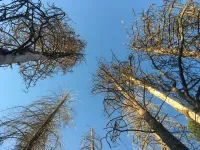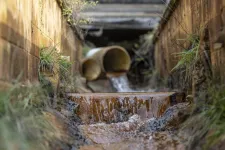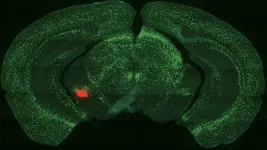(Press-News.org) LOS ALAMOS, N.M., April 4, 2023—Ponderosa pine forests in the Sierra Nevada that were wiped out by western pine beetles during the 2012-2015 megadrought won’t recover to pre-drought densities, reducing an important storehouse for atmospheric carbon.
“Forests store huge amounts of atmospheric carbon, so when western pine beetle infestations kill off millions of trees, that carbon dioxide goes back into the atmosphere,“ said Zachary Robbins, a postdoctoral at Los Alamos National Laboratory.
Robbins is corresponding author of a new paper published in the journal Frontiers in Environmental Science about carbon stored in living ponderosa pines in the Sierra Nevada of California.
“We also found that because so many trees died during the megadrought, there’s much less risk of another huge die-off this century because the bark beetles will have fewer host trees,” he said.
A mixed bag of impacts
It’s a mixed bag, however. Western pine beetle outbreaks driven by climate change will continue to occur, limiting forest regeneration after the drought.
“Some carbon loss won’t be resequestered in trees, but fewer trees on the landscape dampens the severity of western pine beetle outbreaks,” Robbins said. “The forest seems to reach an equilibrium at a certain point.”
The beetle needs a minimum density of trees to support explosive population growth. “Our paper found that as forests reach a certain threshold of ponderosa pine density, they become exponentially more likely to have western pine beetle-driven die-off,” Robbins said.
Complex interactions among climate change, weather, trees and beetles are decimating ponderosa forests in California and elsewhere. During the 2012-2015 drought, an estimated 129 million trees of various species died in the Sierra Nevada.
Carbon sink or carbon source?
As carbon sinks, forests sequester, or store, more than a tenth of the greenhouse-gas emissions in the United States. Trees can use the increasing carbon in the air to grow and thus fix more carbon in the form of wood.
“If there’s no disturbance, such as a beetle outbreak, then the carbon gets stored, but when the beetle comes with the higher temperatures of climate change, their populations develop more rapidly,” said Chonggang Xu, a senior scientist at Los Alamos and a co-author of the paper. “Fewer beetles die in the winter because of warmer minimum temperatures.”
Add in climate-driven drought, and “it all contributes to more frequent beetle outbreaks,” Xu said.
“The ecosystem has been fundamentally changed by the effects of climate change,” Xu said. “That means the forest can’t recover to the pre-megadrought carbon level.”
During an outbreak, millions of trees die and begin releasing carbon back to the atmosphere through microbial decay.
Carbon-budget buster
Xu said it’s critical for future carbon budgeting to include the effects on forest regeneration caused by beetle outbreaks and other disturbances such as drought and fire. Carbon budgeting involves understanding how to manage carbon emissions to prevent catastrophic warming.
Rising temperatures also compound the effects of drought. “In the past, a three-year drought would have substantial impact on tree mortality,” Xu said. “But in a warmer future, a two-year drought could have similar consequences.”
Robbins, Xu and their collaborators simulated forests and beetle dynamics at 31 sites where ponderosa pines predominate in the central and southern Sierra Nevada. To study tree growth, regeneration and background mortality, they modeled insect mortality and phenology (cyclical biological events), tree defense and insect attacks.
They considered two periods, 2006-2018 and 2018-2100. The team used data from observations and modeling to simulate the climate for each site for 2006-2018 and they used climate model data alone for the 2018-2100 projections.
Outbreaks in California and beyond
The work has implications for ponderosa forests beyond California.
“Many of the interactions we describe here are very similar to those across the West, where you have warming temperatures helping beetle populations and you have dense forests of stressed trees, which will continue to be stressed by future drought,” Robbins said. “That will increase the risk of outbreaks. Our paper is specific to California, but it’s a fundamental problem and we expect it to be reflected in many different forests throughout the western United States.”
Xu and Robbins said their results reflect what land managers have known for many years: Overstocked pine stands are particularly susceptible to beetle outbreaks. As droughts increase in severity, managers may have to scale back forest density through active management to mitigate the increased risk.
“Our evidence shows there’s a lot to be gained by those proactive management processes,” Robbins said.
In a related 2022 paper, Robbins, Xu and collaborators published a new modeling framework to assess the risk bark beetles pose in many forest ecosystems under climate change. Adding together the effects of compromised tree defenses (15% to 20%) and increased bark beetle populations (20%), the team had determined that 35% to 40% more ponderosa pines would die from beetle attacks for each degree Celsius of warming.
The paper: “Carbon stored in live ponderosa pines in the Sierra Nevada will not return to pre-drought (2012) levels during the 21st century due to bark beetle outbreaks.” Frontiers in Environmental Science. DOI: 10.3389/fenvs.2023.1112756
The funding: Laboratory Directed Research and Development Program of Los Alamos National Laboratory and the University of California National Laboratory Fees Research Program at Los Alamos National Laboratory.
-30-
LA-UR-23-23461
END
Gone for good? California’s beetle-killed, carbon-storing pine forests may not come back
Massive climate-stoked infestations are also unlikely to recur, thanks to lower tree-stand density
2023-04-05
ELSE PRESS RELEASES FROM THIS DATE:
Dual quasars blaze bright at the center of merging galaxies
2023-04-05
Galaxies grow and evolve by merging with other galaxies, blending their billions of stars, triggering bursts of vigorous star formation, and often fueling their central supermassive black holes to produce luminous quasars that outshine the entire galaxy. Some of these mergers eventually go on to become massive elliptical galaxies that contain black holes that are many billions of times the mass of our Sun. Although astronomers have observed a veritable menagerie of merging galaxies with more than one quasar in our own cosmic neighborhood, more distant examples, seen when the Universe was only a quarter of its current age, are quite rare and ...
SFU research aids fight against treatment-resistant superbugs
2023-04-05
Researchers at Simon Fraser University are studying the genes of superbugs to aid the development of new and effective treatments for drug-resistant bacterial infections. Superbugs are characterized as infection-causing bacteria resistant to treatment with antibiotics.
“Antimicrobial resistance occurs when the disease-causing bacteria has ways to overcome the antibiotics that we use in treatment for infections,” says assistant professor Amy Lee, of SFU's Department of Molecular Biology and Biochemistry. The initiative is a collaboration between the Lee Lab and Brinkman Lab, which are working together as ...
Underground water could be the solution to green heating and cooling
2023-04-05
About 12% of the total global energy demand comes from heating and cooling homes and businesses. A new study suggests that using underground water to maintain comfortable temperatures could reduce consumption of natural gas and electricity in this sector by 40% in the U.S. The approach, called aquifer thermal energy storage (ATES), could also help prevent blackouts caused by high power demand during extreme weather events.
“We need storage to absorb the fluctuating energy from solar and wind, and most people are interested in batteries ...
WVU researchers earn $8M for rare earth extraction facility, an economic and environmental game changer
2023-04-05
West Virginia University researchers will continue to develop and advance their pioneering method to extract and separate rare earth elements and critical minerals from acid mine drainage and coal waste, courtesy of $8 million in new funding from the U.S. Department of Energy.
The grant, part of President Joe Biden’s Investing in America agenda, will lead to the design, construction and operation of a pre-commercial demonstration facility for separating and refining rare earth elements and critical minerals, according to Paul Ziemkiewicz, project lead and director of the West Virginia Water ...
Danger or pleasure? How we learn to tell the difference
2023-04-05
Deep within our brain’s temporal lobes, two almond-shaped cell masses help keep us alive. This tiny region, called the amygdala, assists with a variety of brain activities. It helps us learn and remember. It triggers our fight-or-flight response. It even promotes the release of a feel-good chemical called dopamine. Scientists have learned all this by studying the amygdala over hundreds of years. But we still haven’t reached a full understanding of how these processes work.
Now, Cold Spring Harbor Laboratory neuroscientist Bo Li has brought us several important steps closer. His lab recently made a series of discoveries ...
Ice sheets can collapse faster than previously thought possible
2023-04-05
Ice sheets can retreat up to 600 metres a day during periods of climate warming, 20 times faster than the highest rate of retreat previously measured.
An international team of researchers, led by Dr Christine Batchelor of Newcastle University, UK, used high-resolution imagery of the seafloor to reveal just how quickly a former ice sheet that extended from Norway retreated at the end of the last Ice Age, about 20,000 years ago.
The team, which also included researchers from the universities of Cambridge and Loughborough in the UK and the Geological Survey of Norway, mapped more than 7,600 small-scale landforms called ‘corrugation ridges’ across the seafloor. The ridges ...
Chinese researchers achieve superionic hydride ion conduction at ambient temperatures
2023-04-05
Materials that can conduct negatively charged hydrogen atoms in ambient conditions would pave the way for advanced clean energy storage and electrochemical conversion technologies. A research team from the Dalian Institute of Chemical Physics (DICP) of the Chinese Academy of Sciences (CAS) demonstrated a technique that enables a room-temperature all-solid-state hydride cell by introducing and exploiting defects in the lattice structure of rare earth hydrides.
Their study was published in Nature on April 5.
Solid materials ...
Therapy for babies with signs of autism cuts long-term disability costs
2023-04-05
New research evaluating the potential cost savings of a therapy for babies displaying early autism signs has predicted a three dollar return to Australia’s National Disability Insurance Scheme (NDIS) for every dollar invested in therapy.
Published in the prestigious JAMA Network Open, the health economic study drew on the results of a landmark multi-centre randomised clinical trial which reported the world’s first evidence that a therapy commenced in infancy (iBASIS-VIPP)* could reduce early developmental disability to the point where a childhood clinical autism diagnosis was two-thirds ...
CHOP researchers reveal complex assembly process involved in DNA virus replication
2023-04-05
Philadelphia, April 5, 2023—In a twist on the question, “Which came first, the chicken or the egg?”, scientists have long faced a similar question about how human adenovirus replicates: “Which comes first, assembly of the viral particle, or packaging of the viral genome?” Now, in a new study published today in Nature, researchers at Children’s Hospital of Philadelphia (CHOP) have answered that question, showing that viral proteins use a process called phase separation to coordinate production ...
Trends in suicidal thoughts, behaviors among veterans during pandemic
2023-04-05
About The Study: The prevalence of suicidal thoughts and behaviors has not increased for most U.S. veterans during the first three years of the COVID-19 pandemic. However, veterans with pre-existing loneliness, psychiatric distress, and lower purpose in life were at heightened risk of developing new-onset suicidal ideation and suicide planning during the pandemic. Evidence-based prevention and intervention efforts that target these factors may help mitigate suicide risk in this population.
Authors: Ian C. Fischer, Ph.D., of the ...
LAST 30 PRESS RELEASES:
Structure of dopamine-releasing neurons relates to the type of circuits they form for smell-processing
Reducing social isolation protects the brain in later life
Keeping the heart healthy increases longevity even after cancer
Young adults commonly mix cannabis with nicotine and tobacco
Comprehensive review illuminates tau protein's dual nature in brain health, disease, and emerging psychiatric connections
Book prepares K-12 leaders for the next public health crisis
Storms in the Southern Ocean mitigates global warming
Seals on the move: Research reveals key data for offshore development and international ecology
Sports injuries sustained during your period might be more severe
World's first successful 2 Tbit/s free-space optical communication using small optical terminals mountable on satellites and HAPS
Can intimate relationships affect your heart? New study says ‘yes’
Scalable and healable gradient textiles for multi‑scenario radiative cooling via bicomponent blow spinning
Research shows informed traders never let a good climate crisis go to waste
Intelligent XGBoost framework enhances asphalt pavement skid resistance assessment
Dual-function biomaterials for postoperative osteosarcoma: Tumor suppression and bone regeneration
New framework reveals where transport emissions concentrate in Singapore
NTP-enhanced lattice oxygen activation in Ce-Co catalysts for low-temperature soot combustion
Synergistic interface engineering in Cu-Zn-Ce catalysts for efficient CO2 hydrogenation to methanol
COVID-19 leaves a lasting mark on the human brain
Scientists use ultrasound to soften and treat cancer tumors without damaging healthy tissue
Community swimming program for Black youth boosts skills, sense of belonging, study finds
Specific depressive symptoms in midlife linked to increased dementia risk
An ‘illuminating’ design sheds light on cholesterol
Who is more likely to get long COVID?
Study showcases resilience and rapid growth of “living rocks”
Naval Research Lab diver earns Office of Naval Research 2025 Sailor of the Year
New Mayo-led study establishes practical definition for rapidly progressive dementia
Fossil fuel industry’s “climate false solutions” reinforce its power and aggravate environmental injustice
Researchers reveal bias in a widely used measure of algorithm performance
Alcohol causes cancer. A study from IOCB Prague confirms damage to DNA and shows how cells defend against it
[Press-News.org] Gone for good? California’s beetle-killed, carbon-storing pine forests may not come backMassive climate-stoked infestations are also unlikely to recur, thanks to lower tree-stand density






